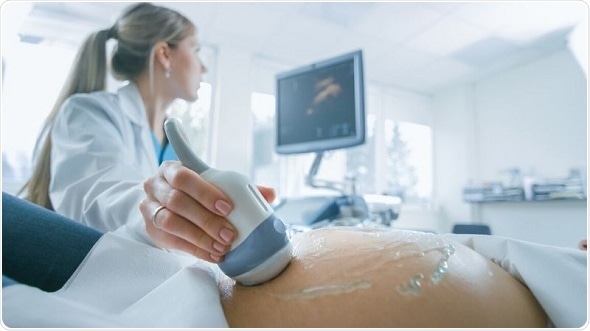Researchers from The Johns Hopkins Center for Fetal Therapy report new evidence that fetuses with severe congenital diaphragmatic hernia (CDH), a rare but life-threatening, lung-damaging condition, experience a significantly high rate of success for the fetal treatment known as FETO, if they and their mothers receive coordinated and highly experienced care in the same expert setting.

Image Credit: Getty Images
A report on the findings was published online, on Feb. 6, in the journal Obstetrics & Gynecology.
FETO — fetoscopic tracheal balloon occlusion — is a minimally invasive procedure in which a fetoscope is inserted through the abdominal wall into the uterus and then into the mouth of the fetus to place an inflatable balloon, to temporarily block the fetal trachea. The blockage allows lung fluids to build up behind the balloon, encouraging expansion of the airways and lung growth. The procedure improves the odds that fetuses with severe CDH acquire sufficient lung function after birth to lead a normal life.
The primary cause of death in babies with CDH is that the lungs do not develop properly, and they cannot breathe outside the womb.”
Ahmet Baschat, M.D., director of The Johns Hopkins Center for Fetal Therapy and professor of gynecology and obstetrics at the Johns Hopkins University School of Medicine
Usually detected through a routine prenatal ultrasound, CDH is a rare condition that impairs lung development, affecting one in 3,000 live births. It is characterized by the partial or complete absence of the diaphragm — the muscle that separates the chest from the abdomen — resulting in a hole. The gap may permit organs that are usually in the abdomen, such as the bowel, the stomach and the liver, to push into the chest. This causes a hernia or bulge, a displacement that leaves too little space for fetal lungs to develop normally. The degree of lung damage is greatest for large hernias, where the liver herniates into the chest. After birth, surgical closure of the hole is possible, but the lung damage that has occurred before birth can make this condition fatal.
To assess the feasibility and impact on the health of mothers and babies after FETO therapy, Johns Hopkins researchers enrolled 14 women, all patients at The Johns Hopkins Center for Fetal Therapy, between May 2015 and June 2019. The women were an average of 28 weeks pregnant and an average of 33 years old.
For the study, Baschat and his team performed successful FETO balloon blockages on all 14 fetuses between 26 and 29 weeks of gestation. No procedure-related fetal or maternal complications occurred. The team removed the balloons at about 33 weeks of gestation, after a median 34 days of blockage.
The researchers say that FETO therapy produced favorable outcomes in the 14 infants born to the mothers in the study when performed in a single center setting, where prenatal and postnatal monitoring and care were highly coordinated.
This is most likely due to prenatal management by a team with experience in fetal interventions, as well as maternal-fetal care in one single institution. From the time of balloon insertion, we had a multidisciplinary team of fetal therapists, neonatologists, pediatric surgeons, pediatric ENTs and obstetric and pediatric anesthesiologists available for any emergency balloon removals and to make sure the fetuses’ airways weren’t obstructed in case of unplanned birth.
FETO has been studied in the past, in the United States and abroad, in a randomized trial, a large feasibility study and several smaller studies, and while the overall approach was comparable to our study, we employed a deliberate strategy to minimize potential contributors to preterm birth associated with premature rupture of membranes."
Ahmet Baschat
Some of these strategies included treating the mothers with vaginal progesterone, avoiding the lower part of the uterus when inserting the fetoscope and aggressive treatment of preterm contractions.
A striking difference in the Johns Hopkins study, Baschat notes, is that delivery of the babies was at an average of 37 weeks of gestation, with no deliveries prior to 32 weeks; 7% of deliveries before 34 weeks and 43% prior to 37 weeks of gestation. This allowed all the infants to be candidates for extracorporeal membrane oxygenation (ECMO) — an advanced life-support technique — which may have been an important contributor to the survival of the infants.
Overall, babies were born about 30 days after balloon removal. All cases experienced a sustained increase in lung size, from 23.2% before blockage to 46.6% prior to birth. All 14 women delivered at The Johns Hopkins Hospital at a median gestational age of 39 weeks (range 33-39). Eight (57%) delivered at term (≥37 weeks of gestation), after scheduled, induced labor. The majority of mothers (71%) delivered their baby vaginally.
“We’ve been able to achieve a really good safety protocol — not only did the procedure result in lung expansion, but balloon removals were all scheduled; they were not emergency procedures,” says Baschat.
Infant survival on day 28 was 93%, and the overall survival to 6 months or hospital discharge was 86%.
All of the babies had absence of the diaphragm on the side of the hernia and required surgical repair of the CDH using a patch, which was performed within the first week of life. The primary complication after surgery in three of the 14 babies (36%) was recurrence of diaphragmatic herniation, due to areas of the patch detaching from the chest wall as the infants grew in size.
“The study had the highest survival rate ever reported for these types of patients, with the lowest complication rate of FETO in terms of procedure risks, obstetric risks and fetal risks,” says Baschat.
Source:
Journal reference:
Baschat, A., et al. (2020) Single-Center Outcome of Fetoscopic Tracheal Balloon Occlusion for Severe Congenital Diaphragmatic Hernia. Obstetrics & Gynecology. doi.org/10.1097/AOG.0000000000003692.